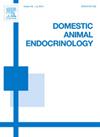The transcriptome of the ovine choroid plexus is regulated by thyroid hormone but not by photoperiod
IF 2.1
2区 农林科学
Q2 AGRICULTURE, DAIRY & ANIMAL SCIENCE
引用次数: 0
Abstract
The photoperiodic control of seasonal functions requires the action of melatonin at the pars tuberalis of the pituitary and subsequent control of local thyroid hormone (TH) signaling by tanycytes lining the basolateral part of the third ventricle. Therefore, TH supply of tanycytes through the cerebrospinal fluid (CSF) produced by the choroid plexuses (CP) is central to photoperiodism. Here, the transcriptome of the CP of the lateral ventricles was established by RNAseq in ewes maintained under three experimental conditions: ewes exposed to a short photoperiod (SP; 8.5 h of light), intact ewes submitted to an acute 3-week exposure to a long photoperiod (LP-Sham; 15.5 h of light) and ewes thyroidectomized prior to the LP exposure (LP-THX). Photoperiod impacted the expression of 1169 genes (SP vs LP-Sham) while 575 genes were sensitive to TH (LP vs LP-THX). Compared to TH-responsive genes, photoperiod-responsive genes displayed rather weak transcriptional changes. In line with this, RT-qPCR for select candidate genes validated the impact of TH, but not that of photoperiod. We demonstrate weak expression of the melatonin MT1 receptor in the CP, which provides a functional rationale for this. In conclusion, the CP appears as a permissive tissue to the expression of TH-dependent seasonality governed by tanycytes rather than being an integral component of the melatonin-dependent photoperiodic response.
羊脉络膜丛的转录组受甲状腺激素的调节,而不受光周期的调节
季节性功能的光周期控制需要褪黑素在垂体结节部的作用,以及随后通过第三脑室基底外侧的伸长细胞控制局部甲状腺激素(TH)信号。因此,通过脉络膜丛(CP)产生的脑脊液(CSF)向伸长细胞供应TH是光周期病的核心。在三种实验条件下:短光周期暴露的母羊(SP; 8.5 h的光),完整的母羊在3周的长光周期暴露(LP- sham; 15.5 h的光),以及在LP暴露前切除甲状腺的母羊(LP- thx),通过RNAseq建立了侧脑室CP的转录组。光周期影响1169个基因(SP vs LP- sham)的表达,575个基因对TH敏感(LP vs LP- thx)。与促甲状腺素应答基因相比,光周期应答基因表现出较弱的转录变化。与此相一致的是,对选择的候选基因的RT-qPCR验证了TH的影响,而不是光周期的影响。我们证明褪黑激素MT1受体在CP中的弱表达,这为这提供了功能上的基本原理。总之,CP似乎是一个允许组织表达由伸长细胞控制的th依赖性季节性,而不是褪黑激素依赖性光周期反应的一个组成部分。
本文章由计算机程序翻译,如有差异,请以英文原文为准。
求助全文
约1分钟内获得全文
求助全文
来源期刊

Domestic animal endocrinology
农林科学-奶制品与动物科学
CiteScore
5.50
自引率
4.80%
发文量
58
审稿时长
31 days
期刊介绍:
Domestic Animal Endocrinology publishes scientific papers dealing with the study of the endocrine physiology of domestic animal species. Those manuscripts utilizing other species as models for clinical or production problems associated with domestic animals are also welcome.
Topics covered include:
Classical and reproductive endocrinology-
Clinical and applied endocrinology-
Regulation of hormone secretion-
Hormone action-
Molecular biology-
Cytokines-
Growth factors
 求助内容:
求助内容: 应助结果提醒方式:
应助结果提醒方式:


